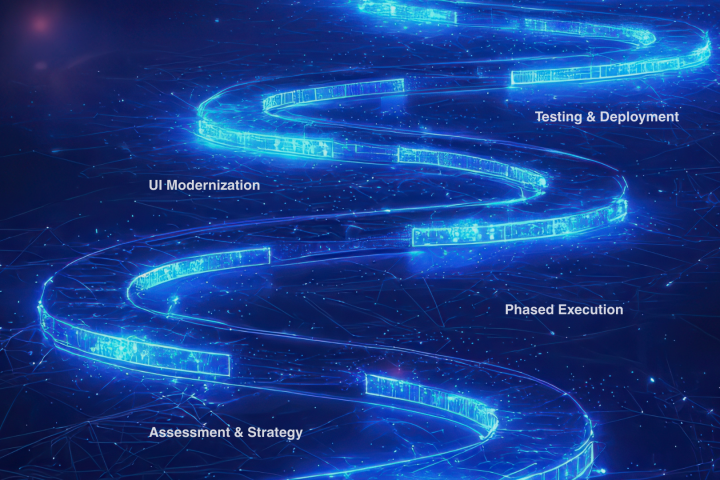
How do you keep IT systems efficient while you adopt new technologies and control costs?
For IBM i environments—known for their reliability and scalability—this question takes on even greater significance. The challenge to balance performance, cost, and innovation can push businesses to a tipping point.
The decision often comes down to two paths:
- Manage In-House: Create and manage an internal team. While this offers control, it demands significant investment and risks skill shortages.
- IBM i Managed Services: Partner with external experts who bring proven tools, specialized knowledge, and the flexibility to scale quickly.
This choice isn’t just about budgets. It defines how fast your business adapts to change, meets customer demands, and modernizes operations in an unpredictable market.
The wrong decision risks prolonged downtime, skill gaps, and stalled modernization. The right one unlocks efficiency, scalability, and strategic growth.
This blog dissects the trade-offs between these two approaches:
Cost Comparison: The Investment Breakdown
In-House IBM i IT
An in-house IT team gives businesses direct control. Employees focus solely on your business and align their efforts with organizational goals and culture. However, in-house team management often requires significant investment. The average annual salary for an RPG developer in North America exceeds $95,000.
Furthermore, costs extend beyond salaries and benefits to include training and retention programs. Teams also need consistent investments in certifications and tools to remain current. Hiring skilled professionals who understand IBM i environments, such as RPG, COBOL, or Java, can be a lengthy and expensive process, particularly in a competitive market.
IBM i Managed Services
IBM i Managed services offer a more predictable cost structure. Businesses gain access to seasoned IBM i professionals for a fraction of the cost of hiring full-time staff. A Deloitte report highlights that 57% of organizations cite cost reduction as the primary reason to outsource IT services.
Flexible contracts allow businesses to scale their IT support based on project needs.
This means you only pay for the resources you need, whether for ongoing support or specific projects. Managed services eliminate recruitment costs and reduce the financial burden of an internal team.
Key Insight: In-house teams work well for stable operations with predictable needs. For businesses that seek cost efficiency and scalability, managed services offer a more economical alternative.
Expertise and Skills Availability
In-House IBM i IT
An internal team brings deep familiarity with your processes, systems, and organizational culture. With long-term staff, institutional knowledge remains intact, creates smoother workflows, and fewer handoffs.
However, the market for skilled IBM i professionals—particularly those versed in RPG, COBOL, PHP, and Java—remains highly competitive. In the latest IBM i Marketplace Survey, 46 percent of respondents listed IBM i skills as a top concern.
IBM i IT Managed Services
IBM i Managed services provide immediate access to a broad pool of seasoned IBM i experts. These professionals have experience across various industries and projects, which ensures they can handle complex tasks efficiently. With no ramp-up delays, managed services reduce disruptions and deliver results faster.
Key Insight: While in-house teams excel in continuity and culture, managed services provide the depth and breadth of expertise needed to meet business demands.
Scalability and Flexibility
In-House IBM i IT
In-house teams work well when your IT workload remains consistent. They allow complete control over priorities and decisions. However, when workloads increase—for example, during system upgrades, modernization initiatives, or major projects—internal resource expansion becomes a challenge. Recruitment and onboarding processes often delay progress and add to costs. According to a SHRM survey, the average time to fill an IT position is 42 days, which slows agility.
IBM i Managed Services
In a recent survey of over 1,000 business leaders around the world, companies see managed services as part of their ‘playbook’ for sustained transformation.
Whether you require short-term support for a specific project or long-term assistance, managed services scale resources up or down based on your requirements. This ensures your IT operations match business demands with no delays or extra costs. However, it may result in less direct control over day-to-day decisions.
Key Insight: In-house teams excel in familiarity and long-term consistency, while managed services offer scalability and flexibility but may require trade-offs in control and internal expertise.
Security and Compliance: Who Holds the Upper Hand?
In-House IBM i IT
Internal teams offer the advantage of direct oversight. They tailor security measures to align with organizational policies and ensure compliance with industry regulations. However, this approach requires business to stay up to date on new security threats and compliance requirements, which demands training and resource allocation. In fact, 95% of cybersecurity breaches result from human error, often linked to inadequate training.
IBM i IT Managed Services
IBM i managed service providers bring specialized expertise and tools designed to address emerging threats. Many providers offer advanced monitoring, threat detection, and proactive patch management. They also stay current with regulatory changes, minimizing the risk of non-compliance. The drawback? It requires trust in an external partner to handle sensitive data.
Key Insight: In-house teams excel in personalized control over security, but managed services provide proactive, scalable solutions that adapt to new risks and regulations.
Control vs. Innovation: Find the Right Balance
In-House IBM i IT
Internal teams offer unparalleled control over decisions, tools, and strategies. IT leaders maintain autonomy to select technologies and prioritize initiatives that align closely with business objectives. This ensures consistency and cultural fit.
However, innovation can take a backseat as internal resources focus on day-to-day operations, maintenance, and troubleshooting. Without external influence, internal teams may also fall into the trap of “business as usual,” and neglect disruptive solutions that could provide a competitive edge.
IBM i IT Managed Services
IBM i managed service providers bring access to advanced tools and best practices and enable businesses to innovate faster. They introduce frameworks like DevOps for automation or
AI-driven analytics to modernize processes. However, companies must establish clear boundaries and governance frameworks to avoid misalignment between business objectives and external recommendations.
Key Insight: In-house teams retain control, while managed services unlock innovation with deep industry expertise and reduce operational burdens.
The Hybrid Approach: Is It the Best of Both Worlds?
A hybrid IT strategy combines the strengths of in-house teams with the expertise of managed services. This approach allows organizations to retain control over core functions and outsource areas that demand specialized skills or scalability.
- Control Over Mission-Critical Operations: Businesses maintain in-house control of sensitive or proprietary processes to ensure compliance and continuity. For example, a financial institution might keep its core banking operations internal and outsource security monitoring to a managed service provider.
- Risk Management: A hybrid model reduces over-reliance on any single strategy. Businesses retain control over sensitive or critical operations, while external partners manage time-consuming or complex tasks.
- Cost Optimization: Companies allocate resources strategically. High-cost internal talent focuses on strategic initiatives, while external providers handle repetitive or niche tasks at a lower cost.
Choose an IT Strategy That Matches Your Business Needs
The choice between IBM i managed services and in-house teams defines how a business adapts to market demands and technological shifts.
- In-house teams deliver control and continuity for stable operations.
- Managed services bring expertise, scalability, and innovation.
- A hybrid model balances the strengths of both.
For IBM i environments, this choice requires a clear understanding of system strengths and vulnerabilities. Does your team handle challenges effectively, or do you need external expertise to close critical gaps? An IBM i assessment helps uncover risks and align IT strategies with long-term goals.
Assess the risk-level of your IBM i environment and pinpoint areas for improvement. Download Fresche’s IBM i Risk-Level Assessment Checklist to expose vulnerabilities and make informed decisions about the support you need—whether that involves an in-house team, IBM i managed services, or a hybrid approach.


